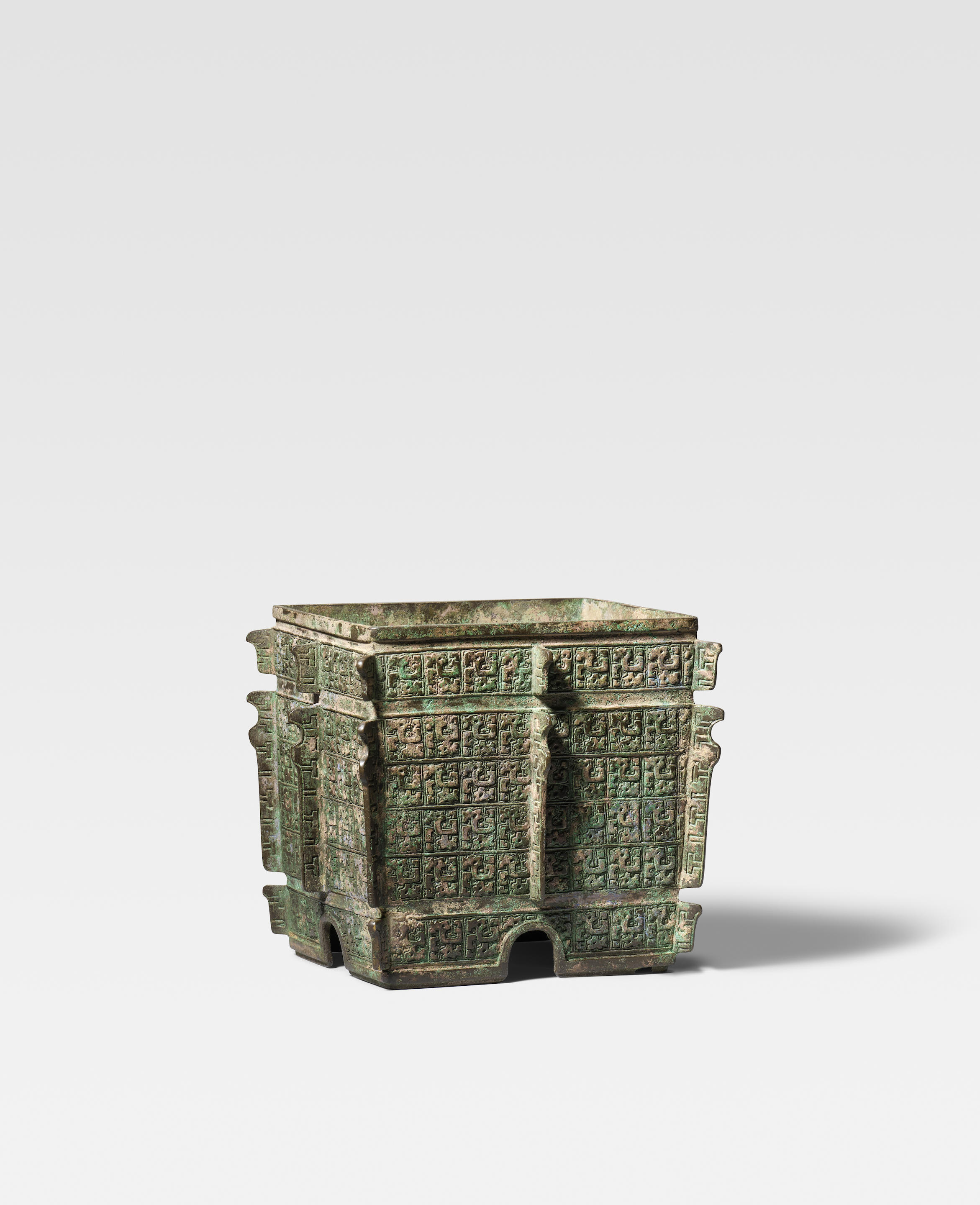A CHENXIANGMU EWER AND A PAIR OF CUPS17th/18th century The teapot carved from a gnarled section of chenxiangmu (eaglewood), with slender tapered sides rising to high shoulders and a slightly flared neck, set with a S-shaped spout opposite a loop handle and a small protruding stump on one side, carved in low relief with a continuous scene of scholars among jagged rocks and verdant trees, one side with three sages conversing near two others engaged in a game of weiqi, the reverse with a group gathered at a table listening to their companion playing on a qin, all below undulous mountains and clouds encircling the shoulder, the handle and spout detailed with prunus branches, the neck decorated with three further scholars and an attendant on a rocky path, the flat cover of conforming irregular outline surmounted by two rows of chrysanthemum petals culminating in a fruit finial, the base, rims and spout mounted in metal, the interior fitted with a metal liner; together with a pair of matching cups carved with sages and attendants sheltered beneath pine and wutong trees. Ewer: 22.2cm (8 3/4in) high; the larger cup: 5.5cm (2 1/4in) wide. (3).Footnotes十七/十八世紀 沉香木雕香山九老執壺及山水人物圖杯一對 Provenance: Collection of A.J. Speelman, London 來源: 倫敦A.J. Speelman收藏 Chenxiangmu was one of the most valued types of wood in China due to its aromatic and medicinal qualities, it is extremely rare to find teapots carved from chenxiangmu as the medium is very brittle and difficult to carve. Hence no other example appears to be known and it is more typically found in smaller articles. Imperial Archives have recorded there was a tribute of chenxiangmu vase sent from Xianjun wang ('Lord of the Xian County') during the Qianlong reign, mentioned in Qing gong ciqi dang'an quanji [Complete Records on Porcelain from the Qing Court], Beijing, 2007, vol.24, p.220; the Court Inventories of the 7th year of the Xianfeng reign (1857) have recorded there was a chenxiangmu vase displayed at the Doumuge in the Palace, see ibid., vol.33, p.341. Chenxiangmu cups made during the Ming and Qing dynasties are mostly decorated with figures and landscapes, compare with a Ming dynasty chenxiangmu 'landscape' cup and a Qing dynasty 'pine and bamboo' cup, illustrated in The Complete Collection of Chinese Bamboo, Wood, Ivory and Rhinoceros Horn Carving, Beijing, 2009, vol.1, nos.44 and 55; a Qing dynasty chenxiangmu 'Eight Immortals' cup with similar composition and carving fashion as the present lot, which was sold at Sotheby's Hong Kong, 28 November 2018, lot 564; another example of an 18th century chenxiangmu 'Drunken Immortals' cup sold at Sotheby's Hong Kong, 22 April 2021, lot 3659. 此組壺杯以沉香木為材,壺蓋分三層,兩層作菊瓣,蓋鈕雕作寶珠狀,壺取整節沉香木,直頸,上浮雕山水高士圖,斜平肩,壺身下收,分六棱,彎流方鋬,上雕連枝梅花,壺身通景淺浮雕香山九老雅集圖,背景有亭台樓閣、山石、松竹梅柳等花草樹木,九老或對弈,或操縵,或清談,壺內壁及底足包錫。二杯浮雕松木林間高士,其中一杯雕一高士坐於竹下,另一面童子在侍,另一杯雕二高士坐而問道,一童子捧桃侍立,杯心包銀。 沉香本為傳統中藥材,使用歷史悠久,早在五代李珣所著《海藥本草》中記載「(沉香)味苦、溫,無毒。主心腹痛,霍亂,中惡邪鬼疰,清人神,并宜酒煮服之。諸瘡腫,宜入膏用」,明代以來以沉香木為材雕刻酒杯或因沉香宜酒煮服之的藥理。沉香木因感染蟲病而結香,因此木質鬆脆,難以下刀雕琢。本套壺杯則雕刻複製,人物開臉生動,實為難得。 翻查清宮舊檔案可知乾隆年間諴郡王曾進貢天然沉香壺一件,見《清宮瓷器檔案全集》,北京,2007年,卷24, 頁220。咸豐七年陳設檔亦記載宮中斗母閣亦陳設有一件然木沉香壺,見前書,卷33,頁341。 沉香杯明清兩代多有製作,所雕多山水松石人物,可比較一件明代沉香木雕山水杯以及一件清代沉香木雕松竹紋杯,見《中國竹木牙角器全集》,北京,2009年,圖版44及55。亦可比較香港蘇富比2018年11月28日售出一件清代沉香木雕八仙賀壽杯,用刀佈局與本件頗似,拍品編號564;又可比較一對十八世紀沉香木雕飲中八仙詩意圖杯,2021年4月22日售於香港蘇富比,拍品編號3659。
A CHENXIANGMU EWER AND A PAIR OF CUPS17th/18th century The teapot carved from a gnarled section of chenxiangmu (eaglewood), with slender tapered sides rising to high shoulders and a slightly flared neck, set with a S-shaped spout opposite a loop handle and a small protruding stump on one side, carved in low relief with a continuous scene of scholars among jagged rocks and verdant trees, one side with three sages conversing near two others engaged in a game of weiqi, the reverse with a group gathered at a table listening to their companion playing on a qin, all below undulous mountains and clouds encircling the shoulder, the handle and spout detailed with prunus branches, the neck decorated with three further scholars and an attendant on a rocky path, the flat cover of conforming irregular outline surmounted by two rows of chrysanthemum petals culminating in a fruit finial, the base, rims and spout mounted in metal, the interior fitted with a metal liner; together with a pair of matching cups carved with sages and attendants sheltered beneath pine and wutong trees. Ewer: 22.2cm (8 3/4in) high; the larger cup: 5.5cm (2 1/4in) wide. (3).Footnotes十七/十八世紀 沉香木雕香山九老執壺及山水人物圖杯一對 Provenance: Collection of A.J. Speelman, London 來源: 倫敦A.J. Speelman收藏 Chenxiangmu was one of the most valued types of wood in China due to its aromatic and medicinal qualities, it is extremely rare to find teapots carved from chenxiangmu as the medium is very brittle and difficult to carve. Hence no other example appears to be known and it is more typically found in smaller articles. Imperial Archives have recorded there was a tribute of chenxiangmu vase sent from Xianjun wang ('Lord of the Xian County') during the Qianlong reign, mentioned in Qing gong ciqi dang'an quanji [Complete Records on Porcelain from the Qing Court], Beijing, 2007, vol.24, p.220; the Court Inventories of the 7th year of the Xianfeng reign (1857) have recorded there was a chenxiangmu vase displayed at the Doumuge in the Palace, see ibid., vol.33, p.341. Chenxiangmu cups made during the Ming and Qing dynasties are mostly decorated with figures and landscapes, compare with a Ming dynasty chenxiangmu 'landscape' cup and a Qing dynasty 'pine and bamboo' cup, illustrated in The Complete Collection of Chinese Bamboo, Wood, Ivory and Rhinoceros Horn Carving, Beijing, 2009, vol.1, nos.44 and 55; a Qing dynasty chenxiangmu 'Eight Immortals' cup with similar composition and carving fashion as the present lot, which was sold at Sotheby's Hong Kong, 28 November 2018, lot 564; another example of an 18th century chenxiangmu 'Drunken Immortals' cup sold at Sotheby's Hong Kong, 22 April 2021, lot 3659. 此組壺杯以沉香木為材,壺蓋分三層,兩層作菊瓣,蓋鈕雕作寶珠狀,壺取整節沉香木,直頸,上浮雕山水高士圖,斜平肩,壺身下收,分六棱,彎流方鋬,上雕連枝梅花,壺身通景淺浮雕香山九老雅集圖,背景有亭台樓閣、山石、松竹梅柳等花草樹木,九老或對弈,或操縵,或清談,壺內壁及底足包錫。二杯浮雕松木林間高士,其中一杯雕一高士坐於竹下,另一面童子在侍,另一杯雕二高士坐而問道,一童子捧桃侍立,杯心包銀。 沉香本為傳統中藥材,使用歷史悠久,早在五代李珣所著《海藥本草》中記載「(沉香)味苦、溫,無毒。主心腹痛,霍亂,中惡邪鬼疰,清人神,并宜酒煮服之。諸瘡腫,宜入膏用」,明代以來以沉香木為材雕刻酒杯或因沉香宜酒煮服之的藥理。沉香木因感染蟲病而結香,因此木質鬆脆,難以下刀雕琢。本套壺杯則雕刻複製,人物開臉生動,實為難得。 翻查清宮舊檔案可知乾隆年間諴郡王曾進貢天然沉香壺一件,見《清宮瓷器檔案全集》,北京,2007年,卷24, 頁220。咸豐七年陳設檔亦記載宮中斗母閣亦陳設有一件然木沉香壺,見前書,卷33,頁341。 沉香杯明清兩代多有製作,所雕多山水松石人物,可比較一件明代沉香木雕山水杯以及一件清代沉香木雕松竹紋杯,見《中國竹木牙角器全集》,北京,2009年,圖版44及55。亦可比較香港蘇富比2018年11月28日售出一件清代沉香木雕八仙賀壽杯,用刀佈局與本件頗似,拍品編號564;又可比較一對十八世紀沉香木雕飲中八仙詩意圖杯,2021年4月22日售於香港蘇富比,拍品編號3659。















Testen Sie LotSearch und seine Premium-Features 7 Tage - ohne Kosten!
Lassen Sie sich automatisch über neue Objekte in kommenden Auktionen benachrichtigen.
Suchauftrag anlegen